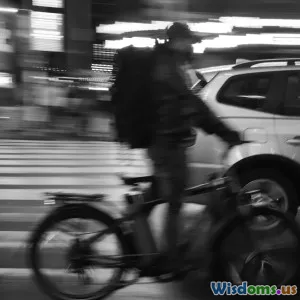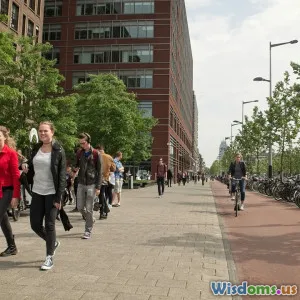
Do E Scooters Make Cities More Accessible for Everyone
9 min read Explore how e-scooters transform urban mobility, enhancing accessibility for diverse city dwellers and breaking barriers in public transportation. (0 Reviews)
Do E-Scooters Make Cities More Accessible for Everyone?
Urban mobility has undergone transformative shifts in recent years, with micro-mobility devices like electric scooters (e-scooters) taking center stage. These compact, battery-powered vehicles have buzzed into cities worldwide, promising to reshape how people navigate urban environments. But beyond the buzz, an essential question arises: do e-scooters genuinely make cities more accessible for everyone? This article delves deep into the ways e-scooters influence urban accessibility, examining nuanced benefits, challenges, and future prospects.
The Accessibility Challenge in Urban Mobility
Urban transportation has long grappled with accessibility issues. Traditional transit systems—buses, metros, trams—don't always cover all city areas or operate on convenient schedules, leaving many underserved. Certain groups—people with disabilities, the elderly, low-income residents—especially face mobility limitations, affecting access to jobs, healthcare, education, and community engagement.
A 2020 study by the National Complements for Mobility Project revealed that approximately 30% of urban residents experience transport-related accessibility issues impacting their quality of life. These gaps highlight an acute need for adaptable and inclusive transportation options.
How E-Scooters Promote Urban Accessibility
Affordability and Convenience
E-scooters typically offer lower costs compared to taxis or ride-hailing services, making them financially accessible to broader populations. Many cities implement tiered pricing, with subsidized rides for low-income users, reducing economic barriers.
For example, in Los Angeles, an e-scooter program called "Beam" offers discounted rides for qualifying users, effectively expanding affordable micro-mobility access. Convenience is key; e-scooters bridge “first and last mile” gaps between public transit stops and final destinations, which can be several blocks away, thus enhancing seamless connectivity.
Geographic Reach and Flexibility
E-scooters can operate on sidewalks, bike lanes, and roads, penetrating areas underserved by traditional transit. This flexibility widens geographic accessibility. In Portland, Oregon, neighborhoods with sparse bus service experienced improved connectivity with e-scooter availability, expanding residents' reach to downtown jobs and services.
Environmental Benefits Supporting Accessibility
Reducing car dependency means less congestion and improved air quality — vital factors for health and accessibility.
A 2019 lifecycle analysis by the University of Chicago highlighted that e-scooters emit 70% less greenhouse gas per mile compared to diesel buses. Improved air quality makes cities more livable, indirectly supporting mobility, particularly for residents with respiratory conditions.
Inclusive Design and Adaptations
While e-scooters come in standard designs, several companies and cities are pioneering accessible models. For instance, "Boost" offers seated e-scooters designed for users with balance issues, addressing physical mobility challenges. This innovation promotes inclusivity for those otherwise unable to use stand-up scooters.
Moreover, geo-fencing technology helps in managing e-scooter zones, restricting rides to safe, accessible paths to prevent accidents and support safe mobility for vulnerable populations.
Real-World Examples
Paris, France
Paris aggressively embraced e-scooters, integrating them into the broader Paris Mobilités initiative. Following initial growing pains related to safety and sidewalk clutter, city authorities established regulations mandating parking zones and limiting speed in dense areas.
Public data shows that 15% of e-scooter use trips replaced previously car-dependent commutes, illustrating a positive shift towards accessible, sustainable transport options.
San Francisco, USA
San Francisco, known for its robust public transit, introduced e-scooter pilot programs with extensive community feedback. The city required operators to ensure equitable user access via features like rebalancing scooters to low-income neighborhoods and offering cash payment options (beyond credit cards).
Such measures enhance accessibility for financially marginalized populations, confirming that policy frameworks significantly influence e-scooter inclusivity.
Singapore
Though densely urban and well-connected by transit, Singapore leverages e-scooters primarily for corporate campuses and controlled neighborhoods to improve localized mobility and reduce shuttle traffic. Customized regulations ensure pedestrian safety while expanding easy, fast connections within micro-environments.
Addressing Criticisms and Challenges
Infrastructure Limitations
Many cities lack sufficient bike lanes or smooth sidewalks, limiting safe scooter use and hindering accessibility gains. Without investments in dedicated micro-mobility infrastructure, the full potential of e-scooters remains untapped.
Safety Concerns
Accident rates and conflicts with pedestrians, especially on shared sidewalks, pose accessibility risks. For example, a 2021 study in Austin, Texas reported that over 40% of e-scooter injuries involved collisions with pedestrians, disproportionately affecting people with visual or mobility impairments.
Digital Divide
Most e-scooter systems operate via smartphone apps, disadvantaging users without smartphones or digital literacy—a barrier for elderly or low-income users. Initiatives like cash payment systems and SMS-based rentals are growing but remain limited.
Regulatory and Equity Issues
Unregulated or poorly managed e-scooter fleets can lead to clutter and inconsistent access. Without equity-centered policies, e-scooters may cluster in affluent neighborhoods, excluding marginalized communities.
Advance planning and robust public-private cooperation are critical to address these challenges.
Future Outlook: Towards Inclusive Urban Mobility
Smart Integration with Public Transit
Integrating e-scooters with transit apps to provide unified payment and journey planning can significantly enhance accessibility. Cities like Copenhagen experiment with Mobility-as-a-Service (MaaS) platforms where e-scooters complement buses and trains logically.
Adaptive Devices and Inclusivity
Manufacturers are developing hybrid e-scooters with features tailored for aging populations and people with disabilities. Governments can incentivize adoption by subsidizing accessible models or fostering shared fleets with diverse vehicles.
Infrastructure Investment
Expanding safe, well-lit bike lanes and pedestrian paths will reduce accident risks and encourage wider e-scooter use, fostering an accessible environment.
Policy and Regulation to Promote Equity
Transparent data collection on usage patterns can inform policies ensuring equitable distribution. Cities should mandate operator engagement with underserved communities, relevant safety education, and flexible payment options.
Conclusion
E-scooters possess significant potential to enhance urban accessibility by offering affordable, flexible, and eco-friendly transportation alternatives. Real-world examples underscore their ability to connect neglected neighborhoods, reduce first-and-last-mile gaps, and integrate with existing transit networks.
However, the full promise of e-scooters is contingent upon thoughtful urban planning, targeted infrastructure development, and inclusive policy frameworks that address safety, equity, and digital barriers. When cities adopt a holistic approach to micro-mobility, e-scooters can become powerful enablers, making urban environments truly accessible to everyone—regardless of income, age, or physical ability.
The journey toward universally accessible cities is ongoing, and e-scooters are a compelling chapter. As stakeholders embrace innovation responsibly, the future of urban mobility looks not only smarter but also more just and inclusive.
By exploring evidence and real-world insights, this article invites city planners, residents, and policymakers to rethink and harness e-scooters as vital tools for building accessible, sustainable cities.
Rate the Post
User Reviews
Other posts in Electric Scooters & Bikes
Popular Posts


















